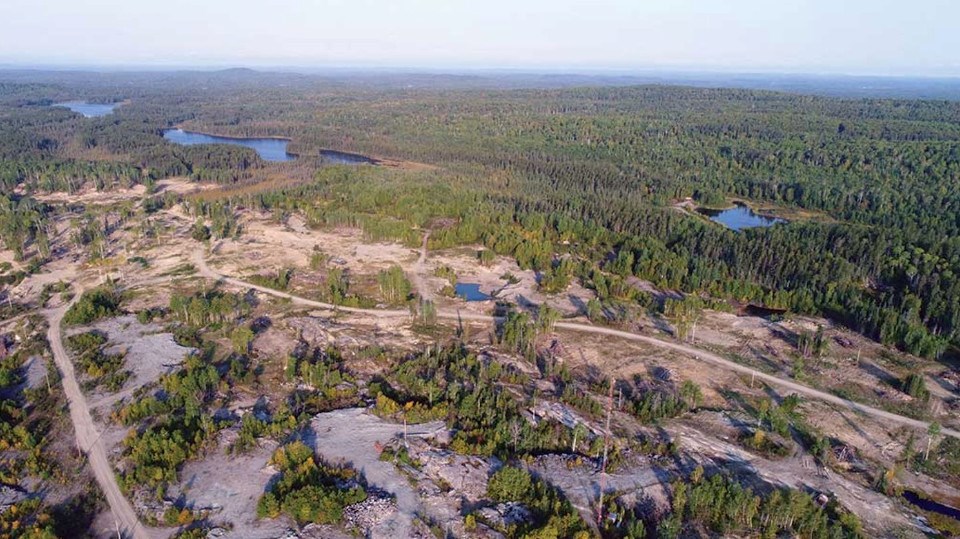The discovery of high-grade gold at Dubreuilville's Magino Mine project may deliver some longevity to the mine's life.
With site preparation just getting underway for an open-pit mine, Argonaut Gold is already talking about a major mine expansion, after finding high-grade mineralization below and beside the proposed pit.
Over a projected 17-year mine life, Magino is expected to produce approximately 2.2 million ounces of gold. The first five years of gold production are expected to average 150,000 ounces annually.
The presence of high-grade gold introduces the real possibility of both an open-pit and an underground operation.
In a recent webcast to investors, Dan Symons, Argonaut's vice-president of corporate development and investor relations, said Magino's mine life could more than double as they begin planning to become a 300,000-ounce-a-year producer based on what they're seeing in the exploration program.
Producing 150,000 ounces of gold a year is "meaningful" for a mid-tier gold producer the size of Argonaut, he said. Boosting that to 300,000 ounces a year is "very meaningful for anybody in this industry."
"We're really excited about the potential."
Magino was a former underground mine of the same name, developed after the First World War. The mine project is 10 kilometres southeast of Dubreuilville on 2,200 hectares. When operational in 2023, the mine is expected to provide employment for 350.
The deposit contains 4.2 million ounces of gold in the measured and indicated category, with more than 2 million ounces on the proven and probable side.
Heading into this year and 2022, the company will be looking at expansion studies to analyze the economics of expanding up from a 10,000-tonne-per-day processing operation to 20,000 tonnes per day, as they consider their underground mining options.
When Argonaut pours its first gold bars from Magino during the first half of 2023, Symons said, they'll have enough data to formulate a better picture of the scale of their operation and how they'll start accessing the high-grade mineralization underground.
"By the time we get to 2023 and we start producing gold, we will already have an answer on what that expansion will look like."
Argonaut has set aside $10 million in the Magino exploration budget for this year, targeting high-grade gold mineralization in the deeper areas below its proposed open pit.
"The potential here is you're likely to be running 30 years-plus with the way the ore body is growing."
Geologically speaking, Magino sits on a structure known as the Goudreau Deformation district, running east off of Lake Superior.
The belt is host to the former Renabie Mine, once a two-million-ounce gold producer for Barrick Gold; Wesdome's Eagle River Mine; and Argonaut's neighbour to the east, Alamo Gold's Island Gold Mine, considered one of the industry's highest grade, lowest cost operations.
Symons said the exploration evidence suggests that the Archean gold systems within this district contain higher grades at depth. The deeper you go, the better the grades. The proof is the pudding with the high-grade discoveries made and longevity demonstrated at Eagle River and Island Gold.
"These are two of the best, pound for pound, mines in Canada today," he said.
Argonaut adopted the same deep exploration exploration strategy in the second half of 2019 after finishing a feasibility study for their pit. They encountered high-grade intercepts after drilling the east edge of the pit.
Mineral resources within the pit design averaged 1.1 grams per tonne. Outside the pit, the grades improved to five and 10 grams per tonne and better at depth.
Argonaut has now identified multiple high-grade gold zones and traced a mineralized strike length at its South Zone that starts at the property line with Alamos and runs 1.5 kilometres west from the boundary.
Their previous drilling was limited to 300 metres depth. Argonaut's current program is reaching down to 1,000 metres, on par with exploration next door at Island Gold.
Symons said it's impressive what the pit is showing and what the underground potential is starting to reveal.
"We really feel like we're just scratching the surface of the potential of this mineralized system."
On the mine construction side, Argonaut filed the last of its major regulatory hurdles in January with the submission of a mine closure plan with the province, thus putting the wheels in motion to begin site preparation.
This quarter, contractors are clearing ground for the pit and the processing facility; Earthworks construction begins in the spring. By fall, workers will be pouring concrete, erecting steel and closing in buildings to be able to work during the winter months. Ausenco Engineering is building the processing plant.
The addition of a second mine near Dubreuilville has been cause for excitement in this neck of the woods of northeastern Ontario.
For decades, Dubreuilville's economy was solely reliant on the sawmilling industry. The mill was shuttered in 2008 but the nearby Island Gold underground mine was a year into commercial production.
With impact benefit agreements in place with area First Nations, Symons said, local Indigenous people and companies are being contracted for site clearing, camp and catering services, and a host of other upcoming jobs.
Mining is now the number one employer in the area, said Symons, and there's great community support.
"People see the economic benefit of what happens when a mine comes into the area."
Magino is the Toronto miner's only Canadian asset. The company operates three mines in Mexico and one in Nevada.
